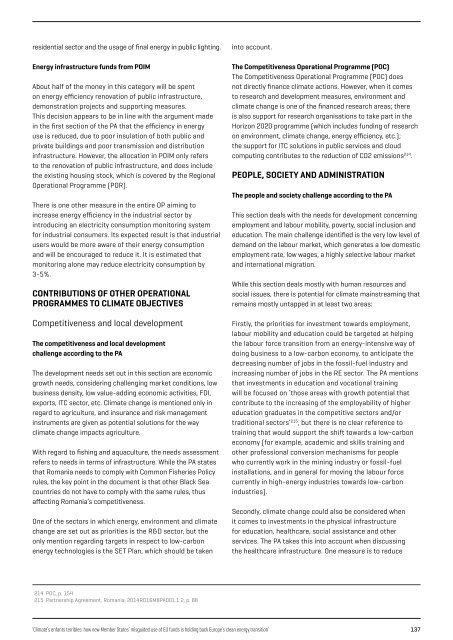ENFANTS TERRIBLES
enfants-terribles
enfants-terribles
You also want an ePaper? Increase the reach of your titles
YUMPU automatically turns print PDFs into web optimized ePapers that Google loves.
esidential sector and the usage of final energy in public lighting.<br />
Energy infrastructure funds from POIM<br />
About half of the money in this category will be spent<br />
on energy efficiency renovation of public infrastructure,<br />
demonstration projects and supporting measures.<br />
This decision appears to be in line with the argument made<br />
in the first section of the PA that the efficiency in energy<br />
use is reduced, due to poor insulation of both public and<br />
private buildings and poor transmission and distribution<br />
infrastructure. However, the allocation in POIM only refers<br />
to the renovation of public infrastructure, and does include<br />
the existing housing stock, which is covered by the Regional<br />
Operational Programme (POR).<br />
There is one other measure in the entire OP aiming to<br />
increase energy efficiency in the industrial sector by<br />
introducing an electricity consumption monitoring system<br />
for industrial consumers. Its expected result is that industrial<br />
users would be more aware of their energy consumption<br />
and will be encouraged to reduce it. It is estimated that<br />
monitoring alone may reduce electricity consumption by<br />
3-5%.<br />
CONTRIBUTIONS OF OTHER OPERATIONAL<br />
PROGRAMMES TO CLIMATE OBJECTIVES<br />
Competitiveness and local development<br />
The competitiveness and local development<br />
challenge according to the PA<br />
The development needs set out in this section are economic<br />
growth needs, considering challenging market conditions, low<br />
business density, low value-adding economic activities, FDI,<br />
exports, ITC sector, etc. Climate change is mentioned only in<br />
regard to agriculture, and insurance and risk management<br />
instruments are given as potential solutions for the way<br />
climate change impacts agriculture.<br />
With regard to fishing and aquaculture, the needs assessment<br />
refers to needs in terms of infrastructure. While the PA states<br />
that Romania needs to comply with Common Fisheries Policy<br />
rules, the key point in the document is that other Black Sea<br />
countries do not have to comply with the same rules, thus<br />
affecting Romania’s competitiveness.<br />
One of the sectors in which energy, environment and climate<br />
change are set out as priorities is the R&D sector, but the<br />
only mention regarding targets in respect to low-carbon<br />
energy technologies is the SET Plan, which should be taken<br />
into account.<br />
The Competitiveness Operational Programme (POC)<br />
The Competitiveness Operational Programme (POC) does<br />
not directly finance climate actions. However, when it comes<br />
to research and development measures, environment and<br />
climate change is one of the financed research areas; there<br />
is also support for research organisations to take part in the<br />
Horizon 2020 programme (which includes funding of research<br />
on environment, climate change, energy efficiency, etc.);<br />
the support for ITC solutions in public services and cloud<br />
computing contributes to the reduction of CO2 emissions 214 .<br />
PEOPLE, SOCIETY AND ADMINISTRATION<br />
The people and society challenge according to the PA<br />
This section deals with the needs for development concerning<br />
employment and labour mobility, poverty, social inclusion and<br />
education. The main challenge identified is the very low level of<br />
demand on the labour market, which generates a low domestic<br />
employment rate, low wages, a highly selective labour market<br />
and international migration.<br />
While this section deals mostly with human resources and<br />
social issues, there is potential for climate mainstreaming that<br />
remains mostly untapped in at least two areas:<br />
Firstly, the priorities for investment towards employment,<br />
labour mobility and education could be targeted at helping<br />
the labour force transition from an energy-intensive way of<br />
doing business to a low-carbon economy, to anticipate the<br />
decreasing number of jobs in the fossil-fuel industry and<br />
increasing number of jobs in the RE sector. The PA mentions<br />
that investments in education and vocational training<br />
will be focused on ‘those areas with growth potential that<br />
contribute to the increasing of the employability of higher<br />
education graduates in the competitive sectors and/or<br />
traditional sectors’ 215 , but there is no clear reference to<br />
training that would support the shift towards a low-carbon<br />
economy (for example, academic and skills training and<br />
other professional conversion mechanisms for people<br />
who currently work in the mining industry or fossil-fuel<br />
installations, and in general for moving the labour force<br />
currently in high-energy industries towards low-carbon<br />
industries).<br />
Secondly, climate change could also be considered when<br />
it comes to investments in the physical infrastructure<br />
for education, healthcare, social assistance and other<br />
services. The PA takes this into account when discussing<br />
the healthcare infrastructure. One measure is to reduce<br />
214 POC, p. 154<br />
215 Partnership Agreement, Romania, 2014RO16M8PA001.1.2, p. 88<br />
‘Climate’s enfants terribles: how new Member States’ misguided use of EU funds is holding back Europe’s clean energy transition’ 137


